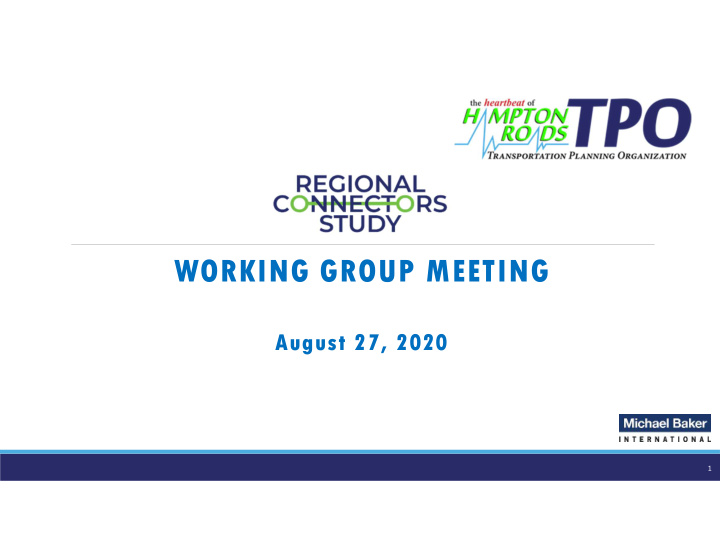



WORKING GROUP MEETING August 27, 2020 1
TRAVEL DEMAND MODELING 2
Impacts on Regional Roadway Network (Daily) 2017 2045 % 2045 % Description Base Baseline Chang Baseline Chang Year w/o Tech e* w/Tech e* Vehicle-Miles 43,150,459 42,574,865 -1.3% 47,591,973 10.3% Traveled Vehicle-Hours 1,201,853 1,124,961 -6.4% 1,293,648 7.6% Traveled Delay (Hours) 244,459 174,345 -28.7% 223,805 -8.4% Average Free-flow 45.1 44.8 -0.7% 44.5 -1.3% Speed (mph) Average Congested 35.9 37.8 5.3% 36.8 2.5% Speed (mph) *compared with 2017 Base Year
Impacts on Regional Roadway Network (Daily) % % 2045 % 2045 2045 Description Chang Chang Suburb Chang Water Urban e e* an e* Vehicle-Miles 51,207,860 7.6% 48,451,514 1.8% 51,041,632 7.3% Traveled Vehicle-Hours 1,438,260 11.2% 1,258,113 -2.7% 1,425,114 10.2% Traveled Delay (Hours) 284,054 26.9% 172,706 -22.8% 278,488 24.4% Average Free-flow 44.4 -0.2% 44.6 0.2% 44.5 0.0% Speed (mph) Average Congested 35.6 -3.3% 38.5 4.6% 35.8 -2.7% Speed (mph) *compared with 2045 Baseline w/ Tech
Change* in 2045 Daily Delay by Facility Type * Compared with 2045 Baseline w/Tech
Change in Daily Delay Due to Congestion (Compared with 2045 Baseline w/Tech) Suburban Water Urban
Change* in 2045 Daily Delay on Harbor Crossings WATER URBAN SUBURBAN X,XXX – daily delay in hours. *compared with 2045 Baseline w/Tech
Change* in Daily Volume on Harbor Crossings WATER URBAN SUBURBAN X,XXX – daily volume. *compared with 2045 Baseline w/Tech
DISCUSSION Discuss congestion patterns Are new alternatives needed to address them? What is the key data in the dashboard for assessing needs? 9
Performance ACCESSIBILITY & TRAVEL MODE Measures (Change in) Multimodal accessibility to jobs (Change in) Accessibility index by mode Performance of the transit-serving roadway network [i.e., average ECONOMIC speed] (Change in) Lost productivity from delay (Change in) Mode share index (Economic impact of change in) Labor market accessibility (Change in) Accessibility to major tourist attractions Performance on the freight network - total delay + spatial results (Change in) Percent of freight traffic on secondary streets - total + (Change in) Transit ridership spatial Percent of jobs/pop within (15 min) drive time to airport or Amtrak TRANSPORTATION NETWORK station (Change in) Delay on cross-harbor trips [time and dollar value] Low income household access to employment (Change in) Circuity of cross-harbor trips TECHNOLOGY (Focus is on comparison of scenarios, not network) (Change in) Reliability for cross-harbor trips [time and dollar value] Percent of trips by automated vehicles (Change in) Cross-harbor accessibility (Change in) Percent of travel using facilities with adaptive technologies (Change in) Regional delay [total + spatial] [e.g., V2I, ITS] System reliability Reliability enhancement from technology (Change in) User cost Induced trip demand from technology Cost of forecasted crashes (Change in) Transportation network impact from flood-prone conditions [e.g., delay, trip length, and/or circuity] 10
Next Steps September 22, 9:30 AM - Joint Working Group/Steering (Policy) Committee Meeting – review complete dashboard with congestion- related items and economic impacts Alternative identification, development, and assessment
REFERENCE SLIDE – IF NEEDED 12
Assessing the Effects of Technology AV Penetration vs. Change in Performance Measures Baseline + Baseline + Baseline + Greater Performance 2045 Greater Growth Greater Growth Growth in Measure Baseline 1 on the WATER 2 in URBAN Areas 2 SUBURBAN Areas 2 CAV Adoption Assumption 28% 28% 38% 70% VMT 11.8% 7.6% 1.8% 7.3% Vehicle-Hours Traveled 15.0% 11.2% -2.7% 10.2% Delay (Hours) 28.4% 26.9% -22.8% 24.4% Average Free-flow Speed -0.7% -0.2% 0.2% 0.0% (mph) Average Congested Speed -2.6% -3.3% 4.6% -2.7% (mph) 1 compared with Baseline without Technology 2 compared with Baseline with Technology
Recommend
More recommend